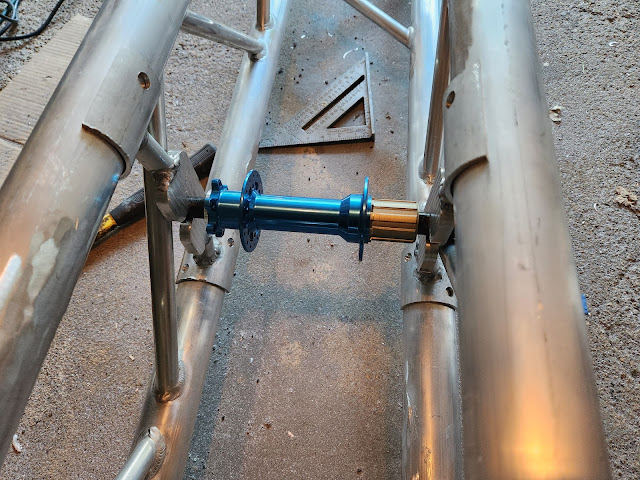I dry fit everything we've made so far on the main truss. Everything mostly went together. The rear supports took a little convincing, but went in relatively easily. The front supports needed some light hammering to mount. Then. The issues. Since I assumed there were going to be issues, I wasn't surprised when I found some.
On the front right side, I managed to install the gussets that we added to the front suspension upside down. smh. I now have to widen that hole in order to connect that CV axle to the differential axle.
On the left side, the front suspension frame warped a little during welding. This pushed the top joint down a little over an 1/8" lower than designed. The knuckle binds when it rotates. This directly affects steering, so it cannot be ignored.
There are holes at the top of the knuckle brackets that the frame tubes fits into. I thought I would have to mill that down a little deeper, but after staring at it for a while, I realized there's an easier fix.
The CV plate sits on ledges that are cut into the sides of the knuckle brackets. I think I can just remove another 1/16" from each ledge--a much easier operation. The knuckles should then fit in the space available and solve the binding issue. 🤞
For the rear supports, I used the new rear wheel hub to check the fit. At first, the hub was difficult to put in place. I realized that the welding beads on the back of the rear brackets were pushing against the truss' cross-members and moving the supports inward. Sliding the brackets down until the beads cleared, solved the problem.
Because each side of the truss' cross-members go in opposite directions, the axle bolt will need to be installed from the side after the wheel is dropped in place. At least we know the rear wheel won't fall off. 😅
After all of that, I broke out my grinder to cut out the truss cross-members that are in the way of mounting the rear wheel.
The structure is now ready for the rear wheel. Of course, there is still one more step. There's always one more step. The new blue hub has to be mounted on the existing rear tire. This will require detaching all the spokes on the 26" tire, rebuilding the wheel with the new hub, and re-balancing the tire.
That seems easy in comparison to other things we've accomplished, but I've never done it before and I have been stalling (i.e. doing other things first)
I should be fine. I've watched this video, like, two times.














.png)





.png)








